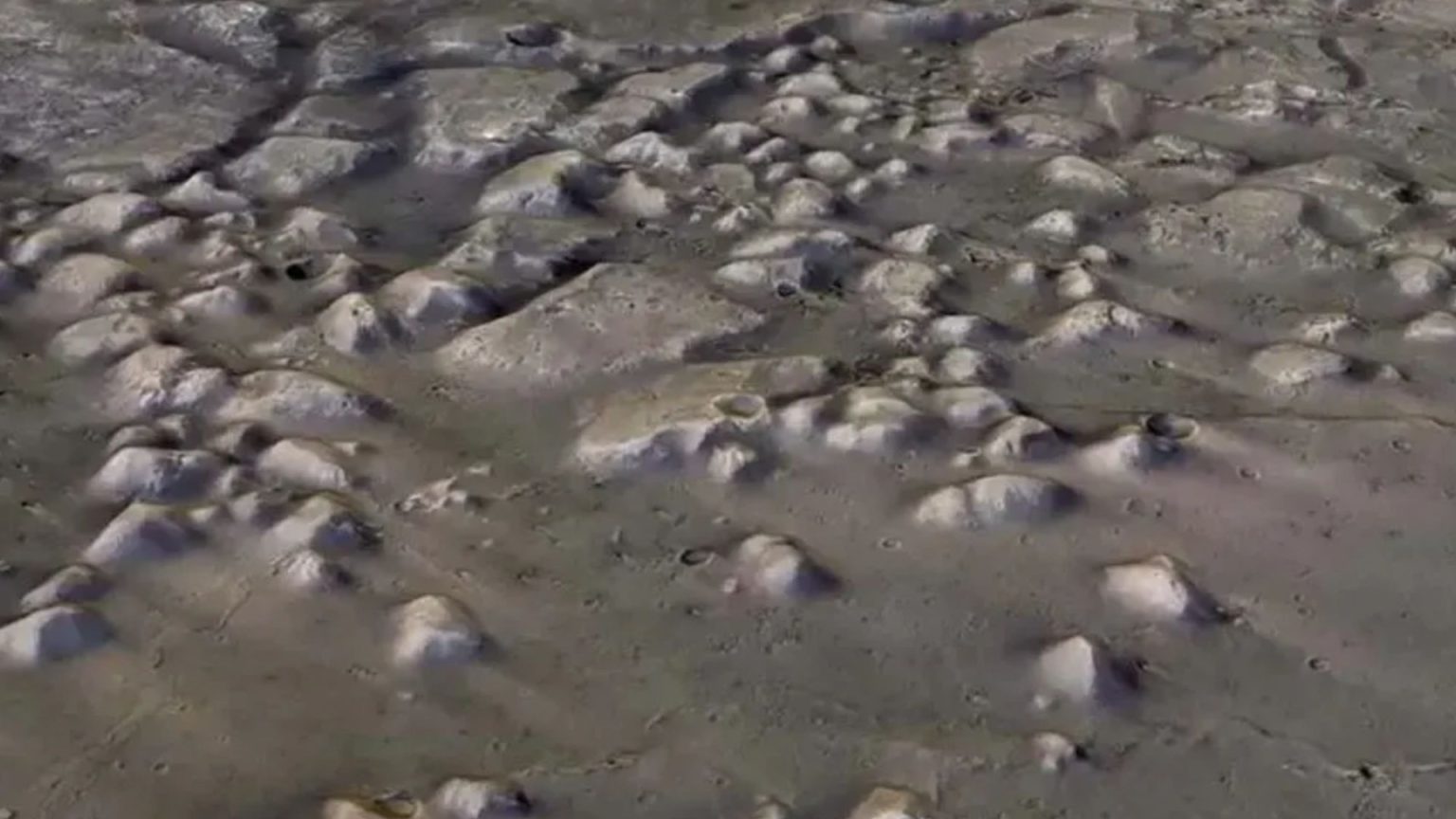The surface of Mars, a canvas of rust-colored dust and ancient geological formations, holds within its features the secrets of a potentially water-rich past. Thousands of mysterious mounds, scattered across a region the size of Texas known as Chryse Planitia, have emerged as a focal point in the quest to unravel the Red Planet’s history and determine whether it once harbored life. These mounds, captured in high-resolution images by NASA and the European Space Agency, offer a tantalizing glimpse into a bygone era, potentially billions of years ago, when water may have flowed freely across the Martian landscape.
The mounds, numbering over 15,000, are not merely random geological formations; they appear strategically positioned, pointing outwards across the Chryse Planitia. Scientists believe these features are remnants of ancient highlands, composed of clay-rich rock that could only have formed in the presence of liquid water. Over billions of years, erosion, possibly caused by flowing water, sculpted these highlands into the mounds we observe today. This erosion process, occurring between 3.8 and 4 billion years ago, may also explain the stark contrast between Mars’ northern and southern hemispheres. The northern lowlands, where Chryse Planitia is located, are significantly lower in elevation than the heavily cratered southern highlands, suggesting a substantial reshaping of the Martian surface.
The implications of this discovery are profound. The presence of these water-formed mounds strengthens the hypothesis that Mars was once a much wetter planet, possibly hosting rivers, lakes, and perhaps even an ocean. This ancient watery environment could have provided the necessary conditions for life to emerge, a possibility that has captivated scientists for decades. The mounds themselves, composed of layered rock formations, hold a chronological record of Mars’ geological history. Each layer represents a distinct period, offering a time capsule of past events waiting to be deciphered. The oldest layers, located at the base of the mounds, date back to approximately four billion years ago, providing a window into the earliest stages of Mars’ evolution.
Dr. Joe McNeil, a planetary scientist and the lead author of the study published in Nature Geoscience, emphasizes the significance of these layered formations. Each layer, he explains, is like a page in a book, narrating the story of Mars’ past. The mounds, reaching heights of up to 1,800 feet, display remarkable structural diversity, further highlighting the complex geological processes that shaped them. While visually reminiscent of the buttes and mesas of Monument Valley in the American Southwest, these Martian mounds are significantly larger, both in height and in the area they cover, emphasizing the scale of the ancient geological activity on Mars.
The upcoming ExoMars Rosalind Franklin rover mission, scheduled to land in 2028, holds great promise for unlocking the secrets held within these mounds. The rover’s landing site is conveniently located near Chryse Planitia, offering an unprecedented opportunity for close-up examination of the mounds. By analyzing the composition and structure of the layered rocks, scientists hope to gain a deeper understanding of Mars’ ancient hydrology and determine whether it ever harbored an ocean. The presence of an ocean, coupled with the evidence of past liquid water, would significantly bolster the possibility that life once existed on the Red Planet.
The mounds represent a crucial piece of the Martian puzzle. Their presence, coupled with other evidence of past water activity, paints a picture of a planet that was once dramatically different from the arid, desolate landscape we see today. Further exploration of these mounds could not only reveal the secrets of Mars’ watery past but also provide valuable insights into the processes that shape planetary evolution and the potential for life beyond Earth.
The mounds stand as silent witnesses to a bygone era, their layered structures preserving a chronological record of Mars’ geological and hydrological history. They offer a tangible link to a time when water may have flowed freely across the Martian surface, carving channels, shaping landscapes, and potentially creating environments conducive to life. The exploration of these mounds is not just a quest to understand Mars’ past; it’s a journey into the possibilities of life beyond Earth and a deeper understanding of the processes that shape the evolution of planets.
The focus of future missions will be to meticulously examine the layers within these mounds, unraveling the story they tell. Through detailed analysis of the rock composition, scientists hope to identify specific minerals and isotopic signatures that could provide further evidence of past water activity and potentially even signs of ancient life. The mounds, therefore, are not merely geological formations; they are time capsules, holding within their layers the secrets of Mars’ past and the potential for a future where we might discover evidence of life beyond our own planet.
The sheer number of these mounds, spread across such a vast area, emphasizes the scale of the ancient hydrological processes that shaped the Martian surface. Their strategic outward orientation also suggests a dynamic system of water flow, potentially from a central source, further supporting the hypothesis of a larger body of water, perhaps an ocean, in Mars’ distant past. The mounds, therefore, are not isolated features; they are interconnected elements of a larger narrative about Mars’ watery past, a story that is still being pieced together.
The upcoming ExoMars Rosalind Franklin rover mission represents a pivotal moment in this ongoing investigation. Equipped with advanced instruments, the rover will be able to analyze the composition of the mounds’ layers in unprecedented detail, providing crucial data that could revolutionize our understanding of Mars’ history. This mission is not just about exploring another planet; it’s about searching for answers to fundamental questions about the origins of life and the potential for its existence beyond Earth.
The discovery of these mounds and their potential significance in unraveling Mars’ watery past has ignited renewed excitement and anticipation within the scientific community. These mysterious features, once overlooked, have now taken center stage in the quest to understand the Red Planet’s history and its potential for harboring life. They represent a tangible link to a bygone era, a time when Mars may have been a vibrant, water-rich world, and their exploration could hold the key to unlocking one of the greatest mysteries of our solar system.











